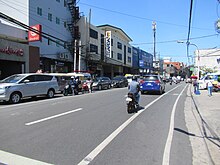 R-6 C-1  | |
|---|---|
 Legarda Street eastbound in Sampaloc | |
 The route of Legarda Street in Metro Manila. Legarda Street is highlighted in red. | |
| Former name(s) | Calle Alix Plaza Santa Ana Calle Concordia |
| Part of | |
| Namesake | Benito Legarda José María Alix y Bonache (formerly) |
| Length | 1.4 km (0.87 mi) |
| Location | Manila |
| East end | |
| Major junctions | |
| West end | |
Legarda Street is a short street located in Sampaloc district in Manila, Philippines. It crosses through the eastern section of the University Belt area in a generally east–west orientation between the Nagtahan Interchange and the intersection with Nepomuceno Street in Quiapo. It is served by Legarda station of the LRTA's Line 2 system.
The street was named after Filipino legislator and resident commissioner to the United States, Benito Legarda y Tuason.[1] Historically, its section in Sampaloc was formerly called Calle Alix (after a Real Audiencia of Manila magistrate of the 1860s, José María Alix y Bonache),[2][3] while its section in Quiapo was formerly called Plaza Santa Ana and Calle Concordia, respectively.[4][5][6]
